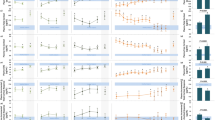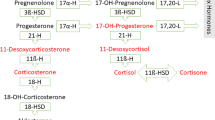Abstract
Objective
To characterise the plasma cortisol profile and adreno-cortial responsiveness (short Synacthen test) of patients in septic shock.
Design
Retrospective assessment using case-notes and ICU charts.
Setting
University teaching hospital ICU.
Patients
68 septic shock patients with plasma cortisol and/or short Synacthen test measured at ICU-admission or onset of shock post ICU-admission. Patients were identified from a total population of 155 patients who had PCL and/or SST measured over a 4.5 year period.
Intervention
None.
Measurements and results
Patients with septic shock had a plasma cortisol ranging from 210–8900 nmol/l and mortality of 56%. There were 22 (32%) below (low) and 46 (68%) above (high) a ‘critical’ plasma cortisol of 500 nmol/l. Using stepwise logistic regression, mortality was adequately predicted by and increased with, increasing plasma cortisol and onset of shock remote from ICU-admission. Short Synacthen tests were available in 33 patients: 11 responders (cortisol increment >200 nmol/l above baseline 30 min after 0.25 mg intravenous Synacthen) and 22 hypo-responders. Mortality in patients was adequately predicted by and increased with a decrease in cortisol increment post-Synacthen. Thirteen patients (plasma cortisol 606±[SD] 297 nmol/l) had complete haemodynamic profiles before inotropic therapy; no relationship was demonstrated between plasma cortisol and circulatory variables. Follow-up revealed no cases of Addison's disease.
Conclusions
In septic shock, ‘hypocortisolaemia’ is not uncommon and does not predict a high mortality; adrenocortical hypo-responsiveness may be associated with poor outcome.
Similar content being viewed by others
References
Cerra FB, Siegel JH, Border JR, Peters DM, McMenamy RR (1979) Correlations between metabolic and cardiopulmonary measurements in patients after trauma, general surgery, and sepsis. J Trauma 19:621–629
Axelrod J, Reisine TD (1984) Stress hormones: their interaction and regulation. Science 224:452–459
Udelsman R, Ramp J, Gallucci WT, Gordon A, Lipford E, Norton JA et al (1986) Adaptation during surgical stress. A re-evaluation of the role of glucocorticoids. J Clin Invest 77:1377–1381
Munck A, Guyre PM, Holbrook NJ (1984) Physiological functions of glucocorticoids in stress and their relation to pharmacological actions. Endocr Rev 5:25–44
Melby JC, Spink WW (1971) Comparative studies on adrenal cortical function and cortisol metabolism in healthy adults and in patients with shock due to infection. J Clin Invest 37:1791–1798
Sibbald WJ, Short A, Cohen MP, Wilson RF (1977) Variations in adrenocortical responsiveness during severe bacterial infections. Ann Surg 186:29–33
Vadas P, Pruzanski W, Stefanski E, Ruse J, Farewell V, McLaughlin et al (1988) Concordance of endogenous cortisol and phospholipase A2 levels in gram-negative septic shock: a prospective study. J Lab Clin Med 111:584–590
Schien RMH, Sprung CL, Marcial E, Napolitano L, Chernow B (1990) Plasma cortisol levels in patients with septic shock. Crit Care Med 18:259–263
Hubay CA, Weckesser EC, Levy RP (1975) Occult adrenal insufficiency in surgical patients. Ann Surg 181:325–332
Catalano RD, Parameswaran V, Ramachandran J, Trunkey DD (1984) Mechanisms of adrenocortical depression during Escherichia coli shock. Arch Surg 119:145–150
Mattingly D, Tyler C (1965) Plasma 11-hydroxycorticoid level in surgical stress. Proc R Soc Med 58:24–26
Sainsbury JRC, Stoddart JC, Watson MJ (1981) Plasma cortisol levels. A comparison between sick patients and volunteers given intravenous cortisol. Anaesthesia 36:16–21
Baue AE, Gunther B, Hartl W, Ackenheil M, Heberer G (1984) Altered hormonal activity in severely ill patients after injury or sepsis. Arch Surg 119:1125–1132
Drucker D, Shandling M (1985) Variable adrenocortical function in acute medical illness. Crit Care Med 13:477–479
Jurney TH, Cockrell JL, Lindberg JS, Lamiell JM, Wade CE (1987) Spectrum of serum cortisol response to ACTH in ICU patients. Correlation with degree of illness and mortality. Chest 92:292–295
Finlay WE, McKee JJ (1982) Serum cortisol levels in severely stressed patients. Lancet I:1414–1415
Span LFR, Hermus ARMM, Bartelink AKM, Hoistma AJ, Gimbrere JSF, Smals AGH et al (1992) Adrenocortical function; an indicator of severity of disease and survival in chronic critically ill patients. Intensive Care Med 18:93–96
Rackow EC, Kaufman BS, Falk JL, Astiz ME, Weil MH (1987) Haemodynamic response to fluid repletion in patients with septic shock: Evidence for early depression of cardiac performance. Circ Shock 22:11–22
Chernow B, Wiley SC, Zaloga GP (1989) Critical Care Endocrinology. In: Schoemaker WC, Ayres S, Grenvik A et al (eds) Textbook of critical care, 2nd edn. Saunders, Philadelphia, pp 736–766
Lindholm J, Kehlet H, Blichert-Toft M, Dinesen B, Riishede J (1978) Reliability of the 30-minute ACTH test in assessing hypothalamic-pituitary-adrenal function. J Clin Endocrinol Metab 47:272–274
Abraham E, Bland RD, Coba JC, Shoemaker WC (1984) Sequential cardiorespiratory patterns associated with outcome in septic shock. Chest 85:75–80
Dixon WJ editor (1990) BMDP statistical software. University of California Press, Vol II, p 1017
Rothwell PM, Udwadia ZF, Lawler PG (1991) Cortisol response to corticotrophin and survival in septic shock. Lancet 337:582–583
Sandberg AA, Eik-Nes K, Migeon CJ, Samuels LT (1956) Metabolism of adrenal steroids in dying patients. J Clin Endocrinol Metab 16:1001–1016
Pugeat M, Bonneton A, Perrot D, Rocle-Nicolas B, Lejeune, Grenot C et al (1989) Decreased immunoreactivity and binding activity of corticosteroid-binding globulin in serum in septic shock. Clin Chem 35:1675–1679
Coolens J-L, Van Balen H, Heyns W (1987) Clinical use of unbound plasma cortisol as calculated from total cortisol and corticosteroid-binding globulin. J Steroid Biochem 26:197–202
Rao HR, Vagnucci AH, Amico JA (1989) Bilateral massive adrenal hemorrhage: Early recognition and treatment. Ann Intern Med 110:227–235
Streeten DHP, Anderson GH, Dalakos TG, Seeley D, Mallov JS, Eusebio R et al (1984) Normal and abnormal function of the hypothalamic-pituitary-adrenocortical system in man. Endocr Rev 5:371–394
Voerman HJ, Srack van Schijndel RJM, Groenveld ABJ, de Boer H, Nauta JP, Thijs LG (1992) Pulsatile secretion during severe sepsis: accurracy of different hormone blood sampling regimens. Metabolism 41:934–940
Nelson JC, Tindall DJ (1978) A comparison of the adrenal responses in hypoglycemia, metyrapone and ACTH. Am J Med Sci 275:165–172
Kuktreja DC, Williams GA (1981) Corticotrophin stimulation test: inverse correlation between basal serum cortisol and its response to corticotrophin. Acta Endcrinol 97:522–524
Vadas P, Waldemar P (1991) Plasma cortisol levels in patients with septic shock. Crit Care Med 19:300
Wade CE, Lindberg JS, Cockrell JL, Lamiell JM, Hunt MM, Ducey J et al (1988) Upon-admission adrenal steroidogenesis is adapted to the degree of illness in intensive care unit patients. J Clin Endocrinol Metab 67:223–227
Blalock JE (1987) New concepts in endocrinology: neuroendocrine and immune system interactions. In: Year Book of Endocrinology, pp 15–28
Kalsner S (1969) Mechanism of hydrocortisone potentiation of responses to epinephrine and norepinephrine in rabbit aorta. Circ Res 24:383–395
Kaumann AJ (1972) Potentiation of the effects of isoprenaline and noradrenaline by hydrocortisone in cat heart muscle. Naunyn-Schmiedeberg's Arch Pharmacol 273:134–153
Chernow B, Roth BL (1986) Pharmacologic manipulation of the peripheral vasculature in shock: clinical and experimental approaches. Circ Shock 18:141–155
Dorin RJ, Kearne PJ (1988) High output circulatory failure in acute adrenal insufficiency. Crit Care Med 16:296–297
Neuman R, Worek FS, Blumel G, Zimmermann GJ, Fehm HL, Pfeiffer JU (1989) Cortisol deficiency in metomidate anaesthetised bacteremic pigs: results in circulatory failure — beneficial effect of cortisol substitution. Acta Anaesthesiol Scand 33:379–384
Zonghai H, Han G, Renbao X (1987) Study of glucocorticoid receptors during intestinal ischemia shock and septic shock. Circ Shock 23:27–36
Author information
Authors and Affiliations
Rights and permissions
About this article
Cite this article
Moran, J.L., Chapman, M.J., O'Fathartaigh, M.S. et al. Hypocortisolaemia and adrenocortical responsiveness at onset of septic shock. Intensive Care Med 20, 489–495 (1994). https://doi.org/10.1007/BF01711901
Received:
Accepted:
Issue Date:
DOI: https://doi.org/10.1007/BF01711901




